 |
|||||
|---|---|---|---|---|---|
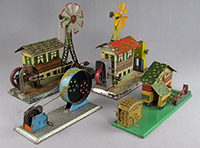 Krauss and successors Centrimotor mounted with accessories. |
Centrimotor flywheel motors by Krauss with the far left “Tippmobil Motor” made by Tipp & Co. No markings on this piece but the 1937 Tipp catalog labeled it the “Tippmobil Motor”. Tipp took over tooling, parts, etc., from Hess after bankruptcy and continued to make toys from some of Hess’s ideas and parts / tooling. Included were this motor, the “Tippmobil Tractor” and an unnamed sedan with Tipp styling of the period but with Hess flywheel motor. The 1937 Tipp and Company catalog lists these toys. Two very early “Centrimotors” and accessories in the background with windmills and painted bases. Green base toy by Keim. | ||||
 |
Wahnschaffe offering of Hess Dynamobils combined with other manufacturer’s toys A. Wahnschaffe was a toy distributor in Nuremberg, Germany in the early 1900s. Apparently they were able to convince toymakers to combine their products to make unique offerings for Wahnschaffe’s customers. This ad from the very early 1900s shows Hess Dynamobils coupled with other manufacturer’s toys to offer “Wahnschaffe Special Models”, exclusively from Wahnschaffe. I do not have any of these in my collection presently, but “Moko” (Moses Kohnstam), another Nuremberg toy distributor of the time, appears to have done the same thing. In my collection is a Moko branded baseplate with Hess Dynamobil and the remnants of what was once some other manufacturer’s product. Founder Moses Kohnstam was an European distributor of German-made toys. Under the Moko trademark. J. Kohnstam Ltd. was established in London in early 1920 and helped launch Lesney Products. ... He also sold the toys using his own brand name, “Moko”. Wahnschaffe had 5 offerings with different accessories attached to the Dynamobils: Item number 8025 was a trip hammer, stamp hammer and transmission. Item number 8026 was a conveyer machine. Item number 8027 was a balloon carousel. Item number 8028 was a trip hammer. Item number 8029 was a mill. (not illustrated) |
||||
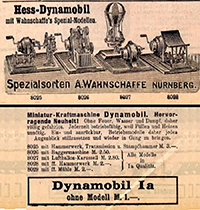 |
|||||
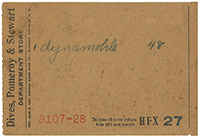 |
Dynamobil Retail Store Receipt An original receipt from the Dives, Pomeroy & Stewart department store for a “Dynamobile”. This department store, originally started in 1878 in Reading, Pennsylvania existed for many years before closing in the 1990s. The receipt book was patented in 1893. |
||||
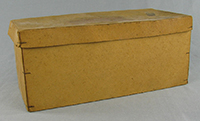 |
Dynamobil Box Dynamobils were packed in plain brown chipboard boxes with lids. There was an unillustrated label pasted on the lid which stated “This toy should never be sold without instructions for use”. Inside were the Dynamobil itself, instructions in several languages and a “special” cord for connecting the motor to the accessory(s). |
||||
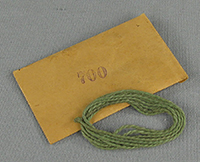 |
|||||
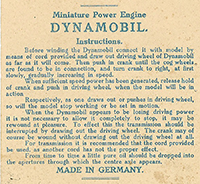 |
Dynamobil Instruction sheet This is an instruction sheet for operating an early Dynamobil with push-pull type clutch. This is just the English part of a longer sheet with instructions in German and French as well. |
||||
.jpg) |
Krauss Centrimotor Powered Toys Krauss made many toys powered by some version of their Centrimotor. Shown is a catalog page from the Krauss 1933 – 34 catalog showing various different combinations. All are on tinplate bases, whereas Hess produced most Dynamobil toys on wooden bases, with a few select pieces on tinplate bases which never exceeded two accessories. |
||||
 |
 |
Britain’s Toys With Flywheel Power, circa 1890s Flywheel power has taken a unique approach with these two Britain’s toys, circa very early 1900s. Both “The Walking Elephant” and “The Mikado” disguise the flywheel as an umbrella on these two toys. A string is wound around the top of the umbrella and pulled, setting the flywheel in motion. The elephant actually walks (on wheels) and the Japanese figure fans himself (fan is missing on this example). The umbrellas are made from cast metal and heavy. The Walking Elephant is tinplate with The Mikado being cast metal.
|
|||

